Sponsored Bird Watch Update
Return to the list of reports
January 2006
- 1st
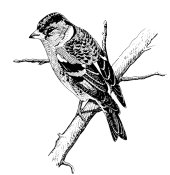 family illness and work commitments ensured a quieter start to the year than was envisaged. A late morning to early afternoon walk along the High Street, Station Road, Flashetts, Bridge Street, Silk Mill and Southington Lanes produced 39 species. The highlights were a Brambling, amongst many other finches, by Butcher's Cottage and a Little Egret by the pools of Southington Mill, the latter soon heading off eastwards as gun fire started. A male Kestrel was patrolling Southington and both Sparrowhawk and Buzzard moved over the Station Road filtration pools, where the number of wildfowl noted was very poor. Marsh Tits and Goldcrests were busy along Station Road and Grey Wagtails were noted almost throughout the walk, Little Grebes were at three sites and a female Siskin joined the Golfinches in Alders by The Surgery. Three Great Spotted Woodpeckers were heard calling but there was not yet sign of any drumming.
family illness and work commitments ensured a quieter start to the year than was envisaged. A late morning to early afternoon walk along the High Street, Station Road, Flashetts, Bridge Street, Silk Mill and Southington Lanes produced 39 species. The highlights were a Brambling, amongst many other finches, by Butcher's Cottage and a Little Egret by the pools of Southington Mill, the latter soon heading off eastwards as gun fire started. A male Kestrel was patrolling Southington and both Sparrowhawk and Buzzard moved over the Station Road filtration pools, where the number of wildfowl noted was very poor. Marsh Tits and Goldcrests were busy along Station Road and Grey Wagtails were noted almost throughout the walk, Little Grebes were at three sites and a female Siskin joined the Golfinches in Alders by The Surgery. Three Great Spotted Woodpeckers were heard calling but there was not yet sign of any drumming.Top right: Brambling, Montifringilla montifringilla
Bottom right: Stonechat Saxicola torquata
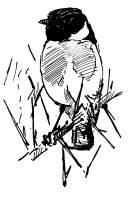 Late afternoon about the fields south of Dellands and across to Turril's Hill added a pair of Stonechats, a further four Buzzards, a male Reed Bunting, a mixed flock of Fieldfare and Redwing, pre-roost movements of Yellowhammers, Meadow Pipits and Pied Wagtails, with at least 15 of the latter being found amongst the Wild Boar. Lesser Black-backed Gulls moved north-east to roost whereas small numbers of both Red-legged Partridge and Pheasant kept tucked in to the sides of fields and the first Carrion Crow strutted about a sheep field. The extra walk moved the total of species noted up to 48, not too bad for walking just a small part of the Parish for just few hours. A total of seven Hares was a bonus on the latter walk, Rabbits also being seen, as on the earlier walk, whilst a Shrew sp. was only heard deep in path side vegetation. The Wild Boar and Buffalo showing far better than any of the native wildlife!
Late afternoon about the fields south of Dellands and across to Turril's Hill added a pair of Stonechats, a further four Buzzards, a male Reed Bunting, a mixed flock of Fieldfare and Redwing, pre-roost movements of Yellowhammers, Meadow Pipits and Pied Wagtails, with at least 15 of the latter being found amongst the Wild Boar. Lesser Black-backed Gulls moved north-east to roost whereas small numbers of both Red-legged Partridge and Pheasant kept tucked in to the sides of fields and the first Carrion Crow strutted about a sheep field. The extra walk moved the total of species noted up to 48, not too bad for walking just a small part of the Parish for just few hours. A total of seven Hares was a bonus on the latter walk, Rabbits also being seen, as on the earlier walk, whilst a Shrew sp. was only heard deep in path side vegetation. The Wild Boar and Buffalo showing far better than any of the native wildlife!- 2nd
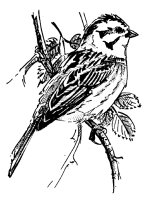 a Stock Dove seen from the back garden was the first addition today, heading rapidly south from the village. Another was seen heading north when a late morning walk was taken from Ashe along The Test to the ford below Polhampton Farm; this on the way to and from 'business' in Basingstoke. The water level remained depressingly low, no wildfowl or waders at all, but another mixed flock of winter and resident thrushes and small numbers of Yellowhammers were about the hedgerows. A Buzzard stood in a field for at least 40 minutes and both Green and Great Spotted Woodpeckers were heard to call in the woodland about the farm. A Linnet heard moving over was far more usual, though now rarer, than the party of 11 Herring Gulls, the 'real' seagull, gradually working their way northwards. Only the second Pheasant of the year made its way across the grass by the source of The Test where both Rooks and Jackdaws were making the most of the less frosty conditions, Leatherjackets beware! The early evening return trip detoured to cover the Straight Lane / Station Road area, though this did not produce any of the hoped-for nocturnal species. The list had grown to 52 during the day.
a Stock Dove seen from the back garden was the first addition today, heading rapidly south from the village. Another was seen heading north when a late morning walk was taken from Ashe along The Test to the ford below Polhampton Farm; this on the way to and from 'business' in Basingstoke. The water level remained depressingly low, no wildfowl or waders at all, but another mixed flock of winter and resident thrushes and small numbers of Yellowhammers were about the hedgerows. A Buzzard stood in a field for at least 40 minutes and both Green and Great Spotted Woodpeckers were heard to call in the woodland about the farm. A Linnet heard moving over was far more usual, though now rarer, than the party of 11 Herring Gulls, the 'real' seagull, gradually working their way northwards. Only the second Pheasant of the year made its way across the grass by the source of The Test where both Rooks and Jackdaws were making the most of the less frosty conditions, Leatherjackets beware! The early evening return trip detoured to cover the Straight Lane / Station Road area, though this did not produce any of the hoped-for nocturnal species. The list had grown to 52 during the day. Left: Yellowhammer, Emberiza citrinella
- 3rd
- back to work today! Not just grim in this respect but a particularly foul day of weather, the murk in the afternoon hardly making up for the noticeably milder temperatures. A late afternoon visit to The Lynch had Water Rail, Kingfisher and two Teal all about the most westerly accessible part of The Test whilst, nearby, the sewage works appeared to hold little.
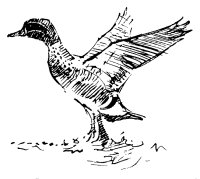 Walking south from Willesley Warren Farm, to The Harroway, in the mist provided compensation in the form of at least two Grey Partridge, amongst many more Red-legged, and a mewing Buzzard. Meadow Pipits, Yellowhammers, Fieldfare and Dunnocks were amongst the hedgerow species moving to roost whereas two Brown Rats and a Hare were still very active; two of the latter being seen in the field south of Southington Close early afternoon. A stop at Frost Hill, and then a drive down the road past Tidnock Farm to the crossroads north of Quidhampton, and then the road back down to Station Road added nothing, excepting 56 Winter Moths! The late day trip pushed the list up to an unexpected 56.
Walking south from Willesley Warren Farm, to The Harroway, in the mist provided compensation in the form of at least two Grey Partridge, amongst many more Red-legged, and a mewing Buzzard. Meadow Pipits, Yellowhammers, Fieldfare and Dunnocks were amongst the hedgerow species moving to roost whereas two Brown Rats and a Hare were still very active; two of the latter being seen in the field south of Southington Close early afternoon. A stop at Frost Hill, and then a drive down the road past Tidnock Farm to the crossroads north of Quidhampton, and then the road back down to Station Road added nothing, excepting 56 Winter Moths! The late day trip pushed the list up to an unexpected 56. Right: Teal, Anas crecca
- 4th
- a post-school walk up Court Drove, in noticeably cooling weather and worsening health, to The Harroway provided three vocal Goldcrests and a Coal Tit in the savaged hedgerow, two Red-legged Partridge and a cock Pheasant in the fields and several Mistle Thrush moving over. Earlier, the pools at Southington Lane continued to hold a duck Tufted Duck whilst two Gadwall moved rapidly eastwards overhead.
- 5th
- late afternoon at Flashetts was quiet, calling Marsh Tit and Great Spotted Woodpecker being of most note, and the wildfowl on the pools off Station Road remained in small numbers; seven species totalling just ?? birds. A Snipe, flushed by a Rabbit, and a Chiffchaff at the latter site where however both new for the year, taking the list up to 58. Heavy clouding hinted all too strongly of snow on the way.
- 6th
- the enforced delivering of mail about the southern end of the village, more staff off sick, had a Sparrowhawk hunting low through gardens in Crawts Road. Also moving over were Pied Wagtails to their roost - has anybody seen where they are currently going to? Both Wood and racing Pigeons were obvious overhead, as were Gold, Green and Chaffinches coming down to feeding stations, along with several Coal Tits. A Linnet may also have been heard on the move, the other birds drowning out its' calls. A Dotted Border, moth, was found on a flat window in Charledown Close. Later, the afternoon school run had a flock of six Lesser Black-backed Gulls making their way into the wintry north-easterly.
- 7th
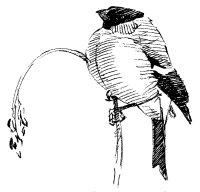 grim weather was ever-present, sleet being the nearest to snow yet noted. Work forced driving and cycling in the afternoon provided another new bird for the year, the 59th, as a male Bullfinch piped and, briefly, settled on a tree in Lordsfield Gardens - now I was not seemingly the only O.B.S. Committee Member who had not seen them this year!Earlier the farmland to the north of the village had yielded hundreds of Fieldfare, several Buzzards and Kestrels, both Red-legged Partridge and Pheasants still seeming to be in poor numbers; a Brown Rat put in an appearance at Walkeridge Farm. The resident wildfowl off Southington Lane had not changed; three stops during the afternoon being made to view from the bridges.
grim weather was ever-present, sleet being the nearest to snow yet noted. Work forced driving and cycling in the afternoon provided another new bird for the year, the 59th, as a male Bullfinch piped and, briefly, settled on a tree in Lordsfield Gardens - now I was not seemingly the only O.B.S. Committee Member who had not seen them this year!Earlier the farmland to the north of the village had yielded hundreds of Fieldfare, several Buzzards and Kestrels, both Red-legged Partridge and Pheasants still seeming to be in poor numbers; a Brown Rat put in an appearance at Walkeridge Farm. The resident wildfowl off Southington Lane had not changed; three stops during the afternoon being made to view from the bridges. Right: Bullfinch, Pyrrhula pyrrhula
- 8th
- short detours on the way to Basingstoke early afternoon, in the worsening weather that had rain falling from late morning, had the resident wildfowl off Southington Lane and Bridge Street and a flock of 250+ Wood Pigeon feeding on brassicas off Straight Lane. The latter stop was opportune in that the trees I was sheltering beneath held an agitated Jay, sounding very like an angry Grey Squirrel - another addition, taking the list to 60. Early evening, on the way back, did not surprise with any sightings of owls and poking my head out of the house several times during the evening fared no better.
- 9th
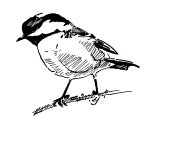 the morning school run yielded the usual suspects on the Southington Lane waters, the duck Tufted Duck being most notable. Heading for a Hampshire Hoopoe was soon cut short; a lunch bag left at home, ah, the wonders of fatherhood, destroying all plans for the day. Lunch time approached and another school run produced a vocal Coal Tit moving off into the Court Drove hedges and another look at the pools. The duck Tufted Duck was still present, but had been joined by the returning, now pretty ancient, feral duck Scaup; a real bonus bird amongst the odds and ends expecting to be fed. She was still present late in the afternoon when pre-roost groupings of Pied Wagtails and Magpies were noted by the sewage works. Nearby, five Teal, a Gadwall and a Kingfisher were at The Lynch.
the morning school run yielded the usual suspects on the Southington Lane waters, the duck Tufted Duck being most notable. Heading for a Hampshire Hoopoe was soon cut short; a lunch bag left at home, ah, the wonders of fatherhood, destroying all plans for the day. Lunch time approached and another school run produced a vocal Coal Tit moving off into the Court Drove hedges and another look at the pools. The duck Tufted Duck was still present, but had been joined by the returning, now pretty ancient, feral duck Scaup; a real bonus bird amongst the odds and ends expecting to be fed. She was still present late in the afternoon when pre-roost groupings of Pied Wagtails and Magpies were noted by the sewage works. Nearby, five Teal, a Gadwall and a Kingfisher were at The Lynch. Left: Coal Tit, Parus ater
- 10th
- the afternoon school run had the duck Scaup now on the pool behind Ashe Waters, the same area holding three Little Egrets that all flew off westwards, Goldfinches were again in a pre-roost flock and a Marsh Tit was about the gardens. Further finches were heading into the trees at the school to roost, Greenfinches and Linnets. The water and fields west of Lower Ashe Farm, as dusk approached, had three Canada Goose, the first this year, a Buzzard struggling southwards in the increasing south-west / southerly wind, three Mistle Thrushes and just four other birds associated with the Test, all being Moorhens. Starlings were continuing to group in the trees by Town Meadow before heading to roost.
- 11th
 no presents this birthday, well none bird wise at least. In the best weather so far this year, time at Micheldever Spoil Heaps yielded 127+ Wood Pigeon on the move, the second Bullfinch and Jays of the year, up to four Stock Dove moving over, a vocal cock Pheasant, a doe Roe Deer and plenty of fungi on the Silver Birch; the latter shining in the late afternoon sunlight. The pools at Southington Lane were quieter still, only the duck Tufted Duck being non-resident. After rain through dawn, the sky had cleared dramatically, remaining blue and sunny through to dusk, the temperatures noticeably up and almost reaching double figures.
no presents this birthday, well none bird wise at least. In the best weather so far this year, time at Micheldever Spoil Heaps yielded 127+ Wood Pigeon on the move, the second Bullfinch and Jays of the year, up to four Stock Dove moving over, a vocal cock Pheasant, a doe Roe Deer and plenty of fungi on the Silver Birch; the latter shining in the late afternoon sunlight. The pools at Southington Lane were quieter still, only the duck Tufted Duck being non-resident. After rain through dawn, the sky had cleared dramatically, remaining blue and sunny through to dusk, the temperatures noticeably up and almost reaching double figures. Right: Mallard, Anas platyrhynchos
- 12th
- an obvious frost cleared to leave southerly winds driving low cloud through the Parish, this only briefly clearing as the day progressed, higher parts of the area perhaps being covered for much of the day. Late afternoon, in low cloud, at Berrydown had a group of 28 Redwings atop trees, a further two being seen nearby. Not even a fly-through Sparrowhawk could dislodge the thrushes in the murk. Single Yellowhammer and Pied Wagtail moved over whilst the local Buffalo and Rabbits were somewhat more confiding. Robins and Dunnocks were in song, the latter the first this year.
- 13th
- a mid-afternoon wander about the football pitch atop Overton Hill, between several work periods, had 37+ Starling, 15+ Chaffinch and three Mistle Thrush feeding in the field adjacent to the eastern boundary, these soon being flushed by dog walkers, unlike the male Kestrel that had come in from the south to the more mature trees. A Goldcrest was in the shelter-belt style conifers and a Yellowhammer was heard close by. A flock of 76 Black-headed Gulls swirling north-east was particularly large for the Parish, presumably having been flushed off the pig fields near Tufton earlier in the afternoon. A milder day with a continuing southerly wind that brought in much higher and darker clouding, no rain and no frost though!
- 14th
- brief spells in the Parish saw the temperature reaching almost double figures again, much rain coming in on the systematic mild southerly wind. The reasons for so little time spent in the area today - 12 hours booked at work and an afternoon twitch of the Hampshire coastal area to see the sixth Cattle Egret for Hampshire, an over wintering Hoopoe and the now regular Ring-billed Gull, the latter two both in Gosport. All were seen very well, making up for the previously cancelled trip, as well as a Mediterranean Gull, 18 Little Egrets, Red-breasted Mergansers, Goldeneye, Sparrowhawk and a Buzzard, the last being just south of Whitchurch.
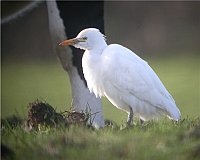
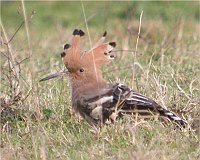
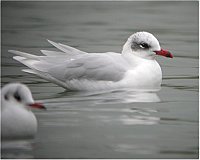
Cattle Egret, Bubulcus ibis - Hoopoe, Upupa epops - Mediterranean Gull, Larus melanocepahlus.
Photographs courtesy of Peter Raby.
- 15th
- the Flashetts Nature Trail area, mid to late morning, provided a Little Egret, two Water Rails, a singing Chiffchaff, a Buzzard and the first Grey Herons of the year - an adult and sub-adult in the quieter areas. The early morning clarity was soon replaced by darkening clouding on the southerly wind, mild and dull would be a fair description of the day. An injured Coot at Quidhampton Mill necessitated a trip to HART, their first contribution from me this year - not quite perhaps what they may have expected! The detour was made particularly worthwhile with a stop at an OBS Committee Members house, seeing a Sparrowhawk over their Kerchers Field garden, a Nuthatch became the second addition of the day as I attempted to leave. This garden watching inspired a little of my own and two Black-headed Gulls were seen to move south-west late morning. Two cock Pheasants and a Yellowhammer were near the 'dog field' as dusk fell.
- 16th
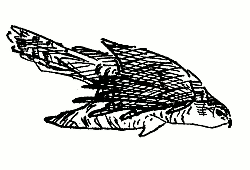 the afternoon school run took in Southington Lane and The Lynch, the duck Scaup being relocated on the pool behind Southington Mill and both Little Egret and Kingfisher feeding about the stream; a drake Tufted Duck was new in on the Southington House pools. An unprecedented police presence in the area was due to "A man with boltcroppers" being seen in the vicinity. Walking Town Meadow before again heading to the school had the Starlings and Wood Pigeons pre-roosting, a Little Grebe whinnying on The Test and fly-through Sparrowhawk and Bullfinch. Both Lesser Black-backed Gull and Canada Geese were seen heading roostwards and a Kestrel was silhouetted against the Court Drove sky; this all on a day when the rain really did drag the enthusiasm down for getting out.
the afternoon school run took in Southington Lane and The Lynch, the duck Scaup being relocated on the pool behind Southington Mill and both Little Egret and Kingfisher feeding about the stream; a drake Tufted Duck was new in on the Southington House pools. An unprecedented police presence in the area was due to "A man with boltcroppers" being seen in the vicinity. Walking Town Meadow before again heading to the school had the Starlings and Wood Pigeons pre-roosting, a Little Grebe whinnying on The Test and fly-through Sparrowhawk and Bullfinch. Both Lesser Black-backed Gull and Canada Geese were seen heading roostwards and a Kestrel was silhouetted against the Court Drove sky; this all on a day when the rain really did drag the enthusiasm down for getting out. Left: Sparrowhawk, Accipiter nisus
- 17th
- pre-dawn walking of Town Meadow had the previous evenings Canada Goose flock, now just 19, moving back westwards and a Little Grebe on The Test. Grey, dull and drizzly, this did not stop many Robins from singing, whereas Blackbirds just seemed to be alarmed by everything! The morning school run took in The Lynch where the duck Scaup had been joined by three Tufted Duck and the Little Egret was again in the stream. Clearing weather was not made the most of, work ensuring that only garden watching, listening really, could be attempted to late in the day.
- 18th
- more staff shortages at work, children surveillance and the RSPB Group meeting in the evening left little time for watching. The weather had warmed notably, 13.5°C mid-afternoon and 7°C recorded hours before dawn, with the light wind bringing much heavy clouding but also allowing much stronger sun to pour through now and then, the latter only during the middle of the day unfortunately. The 66th species of the year was added on the afternoon school run with a sinensis Cormorant low west over Town Meadow, presumably heading towards the roost at Laverstoke Park Lake. Touring the village later had the duck Scaup and Little Egret close to Southington Mill and a Little Grebe newly found on the 'Scaup pool' there. Late night at Polhampton produced no owls and the first outing of the moth trap also produced very little, though a Light Brown Apple Moth had been seen earlier in the afternoon in Bridge Street.
- 19th
- another day of too many hours at work! A mild, grey and dull day, with light drizzle in from early afternoon and the temperature again just pushing up into double figures.
- 20th
- heavy rain pre-dawn, stunningly blue and sunny skies, heavy clouding on a north-westerly and an obvious temperature drop as night fell - a day of changes! The duck Scaup and a Water Rail showed well later in the day at The Lynch. Nearby, seven Magpies, Long-tailed Tits, Moorhens and a Goldcrest were pre-roosting at the sewage works.
- 21st
- work and then London for the Northern Bottle-nosed Whale - a tick at last this year! The watching ended with the whale being lifted on to a barge and starting its journey back out to the open sea, some 40+ miles to the east. Two Greylags flew east, many Cormorants moved up and down The Thames and four species of gull were on the foreshore. Two Ring-necked Parakeets flew north over the M4 near Hounslow and up to three Buzzards were seen from the M3. Back in the Parish late afternoon and both the duck Scaup and Water Rail were showing well by Southington Mill, back to work and finishing after dark, a short detour up Turrill Hill had the first owl of the year seen - a Barn Owl sat on a tree guard just off the road, before heading out over the 'dog field' to hunt; the 67th Parish bird of the year.
- 22nd
- leading the RSPB Basingstoke Local Members Group on their monthly Outdoor Meeting out over The Ridgeway, north-west of Newbury, had five+ Red Kites, four+ Short-eared Owls, a Peregrine, ten+ Corn Buntings, three Lesser Redpolls, five Grey Partridge, five Stonechat, 80+ Golden Plover, 45+ Lapwing, ten+ Buzzards, one+ Sparrowhawk, four+ Kestrels, 110+ Linnet, 20+ Fieldfare, three Stock Dove and a Short-tailed Vole, that I caught before the owls did! The journey there, in thick mist, saw 80+ Fieldfare south-east of the village whilst on returning three Red Kites circled woodland east of Beedon and a Sparrowhawk and two of both Buzzard and Kestrel were added. A heavy frost and thick misting lasted to at least mid-morning with the temperature crawling up to just 6.5°C by midday, the sun and blue sky at this stage ensuring many people were out and about. Late afternoon dog-walking about Quidhampton / Polhampton had a Cormorant, 68 Lesser Black-backed Gulls and 310+ Corvids, mainly Jackdaws, moving north-east and 17 Fieldfares moving south over the higher ground, as well as the first Parish Skylark of the year, whilst 110+ Fieldfares, a Teal and a Black Poplar were by the pools on the lower ground.
- 23rd
- working in the north of Overton during the afternoon yielded little but heading back to the office the Water Rail was seen to show well in the stream west of Southington Mill. Further afield, just four Cormorants were by Laverstoke Park Lake early afternoon.
- 24th
- 2°C on the way to work gave way, reluctantly it seemed, to a high of just 4°C early afternoon, the grey sky turning a watery blue, laced with much high white clouding. Work and family allowed just a 20 minute pre-school pick-up walk up Court Drove in the still present frosting. The commoner hedgerow and woodland edge birds gave way to a calling Red-legged Partridge, a Buzzard flying east over Frost Hill, a female Kestrel and Lesser Black-backed Gulls, also moving east, on entering farmland. A flock of 11 of the latter low along the railway line was fairly typical but a mid-air mixing group of at least 178 was probably the largest pre-roost flock ever noted locally.
- 25th
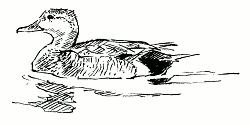
Right: Gadwall, Anas strepera
sub zero and heavy frosting on the way to school did not deter! Another detour to The Lynch and a Green Sandpiper was added to the list, number 69, as well as the duck Scaup and drake Tufted Duck being seen on the Mills' garden pool. Late morning and even the steaming waters of the filtration pools had not escaped the wintry embrace - ice covering much of the most northerly pool. Two Chiffchaffs, a pair of Bullfinches, calling Marsh Tit, a Grey Wagtail and 14+ Long-tailed Tits were the passerine highlights whilst calling Water Rail and Little Grebe, two Teal, 13 Tufted Duck and 28 Gadwall were other records. Two Lesser Black-backed Gulls moved east whereas six Black-headed Gulls made the most of the open water. Work put to the west of Whitchurch provided 188+ Canada Geese, Tufted Ducks, Gadwall and a duck Pochard on Testbourne Lake and a Kestrel, Hare and a black Rabbit, amongst dozens of 'normal individuals', in the countryside about Hurstbourne Priors, Dunley and Litchfield.- 26th
- work and more work! Late afternoon had a visit to a Southington Lane residence enhanced by the usual detour along The Lynch. The duck Scaup was still present and a Little Egret showed to yards in the roadside stream. Nobody was in, but a pre-roost flock of 25 Goldfinches gathered in their garden trees and a Marsh Tit was vocal in the scrub nearby. Heading to Black Dam added a hovering Kestrel over the top of Overton Hill and another, this time settled in a tree, near Ashe. The trip to Basingstoke was cut short by fuel-related car problems, Oakley may be nice but I can think of better things to do than sitting there waiting for help. After a resolution, it was back along the Micheldever road in the hope of adding any of the owls that are resident thereabouts - no luck, as usual.
- 27th
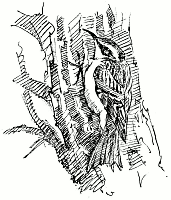 3°C was recorded on the way to work and 4°C on leaving. The wintry feel being enhanced by the north-east / easterly wind that continued to push much clouding across the sky, the sun did however manage to show occasionally during the morning. The afternoon school run was lengthened by a walk through Flashetts and a brief deviation to the railway bridge on Court Drove. The largest tree in Station Road held one of the smallest birds and another addition for the year, a Treecreeper; number 70. Nearby, the filtration pools highlights were a Chiffchaff, two Little Grebes, 39 Gadwall and a Grey Wagtail that moved into the gardens off Station Road. A Little Egret flew east from Flashetts whilst a Kingfisher was only heard. The fields north of Little Meadow attracted two Kestrels to hunt and a Hare that just sat hunched amongst the winter Wheat. Court Drove was quiet, just one of the Kestrels heading back north and some abusive Blue Tits.
3°C was recorded on the way to work and 4°C on leaving. The wintry feel being enhanced by the north-east / easterly wind that continued to push much clouding across the sky, the sun did however manage to show occasionally during the morning. The afternoon school run was lengthened by a walk through Flashetts and a brief deviation to the railway bridge on Court Drove. The largest tree in Station Road held one of the smallest birds and another addition for the year, a Treecreeper; number 70. Nearby, the filtration pools highlights were a Chiffchaff, two Little Grebes, 39 Gadwall and a Grey Wagtail that moved into the gardens off Station Road. A Little Egret flew east from Flashetts whilst a Kingfisher was only heard. The fields north of Little Meadow attracted two Kestrels to hunt and a Hare that just sat hunched amongst the winter Wheat. Court Drove was quiet, just one of the Kestrels heading back north and some abusive Blue Tits. Left: Treecreeper, Certhia familiaris
Below: Ringed Teal, Callonetta leucophrys, in a more traditional habitat!
- 28th
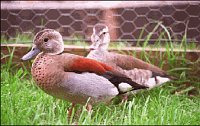 helping the local Watch group in their walk about The Vyne and Morgaston Wood during the afternoon had a drake Ringed Teal on the main lake, this long-staying escapee allowing me to see it for the first time. This probably hails from the wildfowl collection by the Sherborne St. John church and primary school; this species originally from central South America, east of The Andes. A rough translation of its scientific name is 'the beautiful duck with the white wing patches'. 94+ Fieldfare, a Redwing and a Marsh Tit were the passerine goodies noted whilst two Pochard on the main lake and 231 Black-headed and two Lesser Black-backed Gulls and a pair of Teal on the watermeadows were the other water wonders - the sounds from the group when two Grey Herons appeared would however seem to contradict this!
helping the local Watch group in their walk about The Vyne and Morgaston Wood during the afternoon had a drake Ringed Teal on the main lake, this long-staying escapee allowing me to see it for the first time. This probably hails from the wildfowl collection by the Sherborne St. John church and primary school; this species originally from central South America, east of The Andes. A rough translation of its scientific name is 'the beautiful duck with the white wing patches'. 94+ Fieldfare, a Redwing and a Marsh Tit were the passerine goodies noted whilst two Pochard on the main lake and 231 Black-headed and two Lesser Black-backed Gulls and a pair of Teal on the watermeadows were the other water wonders - the sounds from the group when two Grey Herons appeared would however seem to contradict this!- 29th
- visiting Black Dam late morning had several winter birds present: Siskins, Meadow Pipits and Redwing whilst Sparrowhawk, and the long-staying Muscovy, was more commonplace. The light frosting remained with the chilling north-easterly, the sky blue and sunny throughout the day. The first of the organised walks in the Parish, Flashetts Nature Trail, had 14 attending and 34 species recorded (read the full report). A Common Gull was the first in the Parish this year, number 71, two Herring Gulls were only the second record, a Water Rail was in the Flashetts stream where a Kingfisher was heard, a Buzzard flew south-west over the church, two Kestrels were in flight and a Station Road garden held five species of tit, allowing good opportunities to sort out their identification features. A Sparrowhawk was the third raptor of the 'walk', being added on the journey home.
- 30th
-
Right: Golden Plover, Pluvialis apricaria
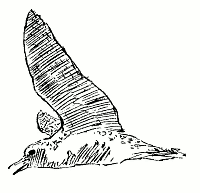 heading north from the village a cloud of birds was seen in the distance, these turning out to be 110+ Golden Plover that were erratically moving over the fields either side of the Kingsclere road. Another hoped for, but unexpected, addition that took the list for the year to 72. The field north of the Hannington road held 28 Fieldfare, six Redwing and eight Mistle Thrush whilst a Kestrel was nearby. On leaving, all were flushed and, in the distance, another group of birds also appeared to be put up - Lapwings! 72 floating back towards the ground, the first of the year and the 73rd species for the list. A Buzzard was seen over the road at Wheathold and a Kestrel was hunting over nearby farmland. The visit to a Wheathold garden saw 150+ Bramblings coming down to the front lawn, the largest flock I have ever seen and a stunning sight. The feeders in the garden were alive with birds, at least 20 species being noted about them. A female Sparrowhawk came through twice, both times failing to catch prey but ensuring a swift exodus of everything on site. Late afternoon and the farmland alongside Laverstoke Lane attracted three Kestrels; several people recently commenting on the apparent resurgence of this species locally. A Little Egret was again in The Test at The Lynch. Nearby two Hares were in fields west of Overton. Waiting by Overton Railway Station and 16+ Pied Wagtails were seen to fly over towards the paper mill shortly before dusk; something else to check out in the future. An accident on the B3400 during the early evening caused a diversion whereby a Barn Owl was seen over roadside fields south of Laverstoke.
heading north from the village a cloud of birds was seen in the distance, these turning out to be 110+ Golden Plover that were erratically moving over the fields either side of the Kingsclere road. Another hoped for, but unexpected, addition that took the list for the year to 72. The field north of the Hannington road held 28 Fieldfare, six Redwing and eight Mistle Thrush whilst a Kestrel was nearby. On leaving, all were flushed and, in the distance, another group of birds also appeared to be put up - Lapwings! 72 floating back towards the ground, the first of the year and the 73rd species for the list. A Buzzard was seen over the road at Wheathold and a Kestrel was hunting over nearby farmland. The visit to a Wheathold garden saw 150+ Bramblings coming down to the front lawn, the largest flock I have ever seen and a stunning sight. The feeders in the garden were alive with birds, at least 20 species being noted about them. A female Sparrowhawk came through twice, both times failing to catch prey but ensuring a swift exodus of everything on site. Late afternoon and the farmland alongside Laverstoke Lane attracted three Kestrels; several people recently commenting on the apparent resurgence of this species locally. A Little Egret was again in The Test at The Lynch. Nearby two Hares were in fields west of Overton. Waiting by Overton Railway Station and 16+ Pied Wagtails were seen to fly over towards the paper mill shortly before dusk; something else to check out in the future. An accident on the B3400 during the early evening caused a diversion whereby a Barn Owl was seen over roadside fields south of Laverstoke.
- 31st
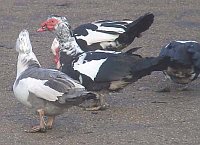 the only Parish watching today was on the way to school during the afternoon - nothing was seen! Black Dam, as dusk brought on a stunning sunset, was more productive with good site birds including two Reed Buntings, Yellowhammer, five Meadow Pipits, Buzzard, Grey Wagtail, Green Woodpecker and the long-staying Muscovy.
the only Parish watching today was on the way to school during the afternoon - nothing was seen! Black Dam, as dusk brought on a stunning sunset, was more productive with good site birds including two Reed Buntings, Yellowhammer, five Meadow Pipits, Buzzard, Grey Wagtail, Green Woodpecker and the long-staying Muscovy. Right: A recent extract from the Surfbirds website:
Muscovy Duck, Cambridgeshire, Ely 22/01/06 © Brett Richards. 4 of the 28 seen at Ely today. What splendid birds! Hopefully, soon to be added to the British List if the BOU can get the agreement of the JNCC. A worthy addition to the British fauna.
-
Return to the list of reports
 family illness and work commitments ensured a quieter start to the year than was envisaged. A late morning to early afternoon walk along the High Street, Station Road, Flashetts, Bridge Street, Silk Mill and Southington Lanes produced 39 species. The highlights were a Brambling, amongst many other finches, by Butcher's Cottage and a Little Egret by the pools of Southington Mill, the latter soon heading off eastwards as gun fire started. A male Kestrel was patrolling Southington and both Sparrowhawk and Buzzard moved over the Station Road filtration pools, where the number of wildfowl noted was very poor. Marsh Tits and Goldcrests were busy along Station Road and Grey Wagtails were noted almost throughout the walk, Little Grebes were at three sites and a female Siskin joined the Golfinches in Alders by The Surgery. Three Great Spotted Woodpeckers were heard calling but there was not yet sign of any drumming.
family illness and work commitments ensured a quieter start to the year than was envisaged. A late morning to early afternoon walk along the High Street, Station Road, Flashetts, Bridge Street, Silk Mill and Southington Lanes produced 39 species. The highlights were a Brambling, amongst many other finches, by Butcher's Cottage and a Little Egret by the pools of Southington Mill, the latter soon heading off eastwards as gun fire started. A male Kestrel was patrolling Southington and both Sparrowhawk and Buzzard moved over the Station Road filtration pools, where the number of wildfowl noted was very poor. Marsh Tits and Goldcrests were busy along Station Road and Grey Wagtails were noted almost throughout the walk, Little Grebes were at three sites and a female Siskin joined the Golfinches in Alders by The Surgery. Three Great Spotted Woodpeckers were heard calling but there was not yet sign of any drumming. Late afternoon about the fields south of Dellands and across to Turril's Hill added a pair of Stonechats, a further four Buzzards, a male Reed Bunting, a mixed flock of Fieldfare and Redwing, pre-roost movements of Yellowhammers, Meadow Pipits and Pied Wagtails, with at least 15 of the latter being found amongst the Wild Boar. Lesser Black-backed Gulls moved north-east to roost whereas small numbers of both Red-legged Partridge and Pheasant kept tucked in to the sides of fields and the first Carrion Crow strutted about a sheep field. The extra walk moved the total of species noted up to 48, not too bad for walking just a small part of the Parish for just few hours. A total of seven Hares was a bonus on the latter walk, Rabbits also being seen, as on the earlier walk, whilst a Shrew sp. was only heard deep in path side vegetation. The Wild Boar and Buffalo showing far better than any of the native wildlife!
Late afternoon about the fields south of Dellands and across to Turril's Hill added a pair of Stonechats, a further four Buzzards, a male Reed Bunting, a mixed flock of Fieldfare and Redwing, pre-roost movements of Yellowhammers, Meadow Pipits and Pied Wagtails, with at least 15 of the latter being found amongst the Wild Boar. Lesser Black-backed Gulls moved north-east to roost whereas small numbers of both Red-legged Partridge and Pheasant kept tucked in to the sides of fields and the first Carrion Crow strutted about a sheep field. The extra walk moved the total of species noted up to 48, not too bad for walking just a small part of the Parish for just few hours. A total of seven Hares was a bonus on the latter walk, Rabbits also being seen, as on the earlier walk, whilst a Shrew sp. was only heard deep in path side vegetation. The Wild Boar and Buffalo showing far better than any of the native wildlife! a Stock Dove seen from the back garden was the first addition today, heading rapidly south from the village. Another was seen heading north when a late morning walk was taken from Ashe along The Test to the ford below Polhampton Farm; this on the way to and from 'business' in Basingstoke. The water level remained depressingly low, no wildfowl or waders at all, but another mixed flock of winter and resident thrushes and small numbers of Yellowhammers were about the hedgerows. A Buzzard stood in a field for at least 40 minutes and both Green and Great Spotted Woodpeckers were heard to call in the woodland about the farm. A Linnet heard moving over was far more usual, though now rarer, than the party of 11 Herring Gulls, the 'real' seagull, gradually working their way northwards. Only the second Pheasant of the year made its way across the grass by the source of The Test where both Rooks and Jackdaws were making the most of the less frosty conditions, Leatherjackets beware! The early evening return trip detoured to cover the Straight Lane / Station Road area, though this did not produce any of the hoped-for nocturnal species. The list had grown to 52 during the day.
a Stock Dove seen from the back garden was the first addition today, heading rapidly south from the village. Another was seen heading north when a late morning walk was taken from Ashe along The Test to the ford below Polhampton Farm; this on the way to and from 'business' in Basingstoke. The water level remained depressingly low, no wildfowl or waders at all, but another mixed flock of winter and resident thrushes and small numbers of Yellowhammers were about the hedgerows. A Buzzard stood in a field for at least 40 minutes and both Green and Great Spotted Woodpeckers were heard to call in the woodland about the farm. A Linnet heard moving over was far more usual, though now rarer, than the party of 11 Herring Gulls, the 'real' seagull, gradually working their way northwards. Only the second Pheasant of the year made its way across the grass by the source of The Test where both Rooks and Jackdaws were making the most of the less frosty conditions, Leatherjackets beware! The early evening return trip detoured to cover the Straight Lane / Station Road area, though this did not produce any of the hoped-for nocturnal species. The list had grown to 52 during the day.  Walking south from Willesley Warren Farm, to The Harroway, in the mist provided compensation in the form of at least two Grey Partridge, amongst many more Red-legged, and a mewing Buzzard. Meadow Pipits, Yellowhammers, Fieldfare and Dunnocks were amongst the hedgerow species moving to roost whereas two Brown Rats and a Hare were still very active; two of the latter being seen in the field south of Southington Close early afternoon. A stop at Frost Hill, and then a drive down the road past Tidnock Farm to the crossroads north of Quidhampton, and then the road back down to Station Road added nothing, excepting 56 Winter Moths! The late day trip pushed the list up to an unexpected 56.
Walking south from Willesley Warren Farm, to The Harroway, in the mist provided compensation in the form of at least two Grey Partridge, amongst many more Red-legged, and a mewing Buzzard. Meadow Pipits, Yellowhammers, Fieldfare and Dunnocks were amongst the hedgerow species moving to roost whereas two Brown Rats and a Hare were still very active; two of the latter being seen in the field south of Southington Close early afternoon. A stop at Frost Hill, and then a drive down the road past Tidnock Farm to the crossroads north of Quidhampton, and then the road back down to Station Road added nothing, excepting 56 Winter Moths! The late day trip pushed the list up to an unexpected 56.  grim weather was ever-present, sleet being the nearest to snow yet noted. Work forced driving and cycling in the afternoon provided another new bird for the year, the 59th, as a male Bullfinch piped and, briefly, settled on a tree in Lordsfield Gardens - now I was not seemingly the only O.B.S. Committee Member who had not seen them this year!Earlier the farmland to the north of the village had yielded hundreds of Fieldfare, several Buzzards and Kestrels, both Red-legged Partridge and Pheasants still seeming to be in poor numbers; a Brown Rat put in an appearance at Walkeridge Farm. The resident wildfowl off Southington Lane had not changed; three stops during the afternoon being made to view from the bridges.
grim weather was ever-present, sleet being the nearest to snow yet noted. Work forced driving and cycling in the afternoon provided another new bird for the year, the 59th, as a male Bullfinch piped and, briefly, settled on a tree in Lordsfield Gardens - now I was not seemingly the only O.B.S. Committee Member who had not seen them this year!Earlier the farmland to the north of the village had yielded hundreds of Fieldfare, several Buzzards and Kestrels, both Red-legged Partridge and Pheasants still seeming to be in poor numbers; a Brown Rat put in an appearance at Walkeridge Farm. The resident wildfowl off Southington Lane had not changed; three stops during the afternoon being made to view from the bridges.  the morning school run yielded the usual suspects on the Southington Lane waters, the duck Tufted Duck being most notable. Heading for a Hampshire Hoopoe was soon cut short; a lunch bag left at home, ah, the wonders of fatherhood, destroying all plans for the day. Lunch time approached and another school run produced a vocal Coal Tit moving off into the Court Drove hedges and another look at the pools. The duck Tufted Duck was still present, but had been joined by the returning, now pretty ancient, feral duck Scaup; a real bonus bird amongst the odds and ends expecting to be fed. She was still present late in the afternoon when pre-roost groupings of Pied Wagtails and Magpies were noted by the sewage works. Nearby, five Teal, a Gadwall and a Kingfisher were at The Lynch.
the morning school run yielded the usual suspects on the Southington Lane waters, the duck Tufted Duck being most notable. Heading for a Hampshire Hoopoe was soon cut short; a lunch bag left at home, ah, the wonders of fatherhood, destroying all plans for the day. Lunch time approached and another school run produced a vocal Coal Tit moving off into the Court Drove hedges and another look at the pools. The duck Tufted Duck was still present, but had been joined by the returning, now pretty ancient, feral duck Scaup; a real bonus bird amongst the odds and ends expecting to be fed. She was still present late in the afternoon when pre-roost groupings of Pied Wagtails and Magpies were noted by the sewage works. Nearby, five Teal, a Gadwall and a Kingfisher were at The Lynch.  no presents this birthday, well none bird wise at least. In the best weather so far this year, time at Micheldever Spoil Heaps yielded 127+ Wood Pigeon on the move, the second Bullfinch and Jays of the year, up to four Stock Dove moving over, a vocal cock Pheasant, a doe Roe Deer and plenty of fungi on the Silver Birch; the latter shining in the late afternoon sunlight. The pools at Southington Lane were quieter still, only the duck Tufted Duck being non-resident. After rain through dawn, the sky had cleared dramatically, remaining blue and sunny through to dusk, the temperatures noticeably up and almost reaching double figures.
no presents this birthday, well none bird wise at least. In the best weather so far this year, time at Micheldever Spoil Heaps yielded 127+ Wood Pigeon on the move, the second Bullfinch and Jays of the year, up to four Stock Dove moving over, a vocal cock Pheasant, a doe Roe Deer and plenty of fungi on the Silver Birch; the latter shining in the late afternoon sunlight. The pools at Southington Lane were quieter still, only the duck Tufted Duck being non-resident. After rain through dawn, the sky had cleared dramatically, remaining blue and sunny through to dusk, the temperatures noticeably up and almost reaching double figures. 


 the afternoon school run took in Southington Lane and The Lynch, the duck Scaup being relocated on the pool behind Southington Mill and both Little Egret and Kingfisher feeding about the stream; a drake Tufted Duck was new in on the Southington House pools. An unprecedented police presence in the area was due to "A man with boltcroppers" being seen in the vicinity. Walking Town Meadow before again heading to the school had the Starlings and Wood Pigeons pre-roosting, a Little Grebe whinnying on The Test and fly-through Sparrowhawk and Bullfinch. Both Lesser Black-backed Gull and Canada Geese were seen heading roostwards and a Kestrel was silhouetted against the Court Drove sky; this all on a day when the rain really did drag the enthusiasm down for getting out.
the afternoon school run took in Southington Lane and The Lynch, the duck Scaup being relocated on the pool behind Southington Mill and both Little Egret and Kingfisher feeding about the stream; a drake Tufted Duck was new in on the Southington House pools. An unprecedented police presence in the area was due to "A man with boltcroppers" being seen in the vicinity. Walking Town Meadow before again heading to the school had the Starlings and Wood Pigeons pre-roosting, a Little Grebe whinnying on The Test and fly-through Sparrowhawk and Bullfinch. Both Lesser Black-backed Gull and Canada Geese were seen heading roostwards and a Kestrel was silhouetted against the Court Drove sky; this all on a day when the rain really did drag the enthusiasm down for getting out. 
 3°C was recorded on the way to work and 4°C on leaving. The wintry feel being enhanced by the north-east / easterly wind that continued to push much clouding across the sky, the sun did however manage to show occasionally during the morning. The afternoon school run was lengthened by a walk through Flashetts and a brief deviation to the railway bridge on Court Drove. The largest tree in Station Road held one of the smallest birds and another addition for the year, a Treecreeper; number 70. Nearby, the filtration pools highlights were a Chiffchaff, two Little Grebes, 39 Gadwall and a Grey Wagtail that moved into the gardens off Station Road. A Little Egret flew east from Flashetts whilst a Kingfisher was only heard. The fields north of Little Meadow attracted two Kestrels to hunt and a Hare that just sat hunched amongst the winter Wheat. Court Drove was quiet, just one of the Kestrels heading back north and some abusive Blue Tits.
3°C was recorded on the way to work and 4°C on leaving. The wintry feel being enhanced by the north-east / easterly wind that continued to push much clouding across the sky, the sun did however manage to show occasionally during the morning. The afternoon school run was lengthened by a walk through Flashetts and a brief deviation to the railway bridge on Court Drove. The largest tree in Station Road held one of the smallest birds and another addition for the year, a Treecreeper; number 70. Nearby, the filtration pools highlights were a Chiffchaff, two Little Grebes, 39 Gadwall and a Grey Wagtail that moved into the gardens off Station Road. A Little Egret flew east from Flashetts whilst a Kingfisher was only heard. The fields north of Little Meadow attracted two Kestrels to hunt and a Hare that just sat hunched amongst the winter Wheat. Court Drove was quiet, just one of the Kestrels heading back north and some abusive Blue Tits.  helping the local Watch group in their walk about The Vyne and Morgaston Wood during the afternoon had a drake Ringed Teal on the main lake, this long-staying escapee allowing me to see it for the first time. This probably hails from the wildfowl collection by the Sherborne St. John church and primary school; this species originally from central South America, east of The Andes. A rough translation of its scientific name is 'the beautiful duck with the white wing patches'. 94+ Fieldfare, a Redwing and a Marsh Tit were the passerine goodies noted whilst two Pochard on the main lake and 231 Black-headed and two Lesser Black-backed Gulls and a pair of Teal on the watermeadows were the other water wonders - the sounds from the group when two Grey Herons appeared would however seem to contradict this!
helping the local Watch group in their walk about The Vyne and Morgaston Wood during the afternoon had a drake Ringed Teal on the main lake, this long-staying escapee allowing me to see it for the first time. This probably hails from the wildfowl collection by the Sherborne St. John church and primary school; this species originally from central South America, east of The Andes. A rough translation of its scientific name is 'the beautiful duck with the white wing patches'. 94+ Fieldfare, a Redwing and a Marsh Tit were the passerine goodies noted whilst two Pochard on the main lake and 231 Black-headed and two Lesser Black-backed Gulls and a pair of Teal on the watermeadows were the other water wonders - the sounds from the group when two Grey Herons appeared would however seem to contradict this! heading north from the village a cloud of birds was seen in the distance, these turning out to be 110+ Golden Plover that were erratically moving over the fields either side of the Kingsclere road. Another hoped for, but unexpected, addition that took the list for the year to 72. The field north of the Hannington road held 28 Fieldfare, six Redwing and eight Mistle Thrush whilst a Kestrel was nearby. On leaving, all were flushed and, in the distance, another group of birds also appeared to be put up - Lapwings! 72 floating back towards the ground, the first of the year and the 73rd species for the list. A Buzzard was seen over the road at Wheathold and a Kestrel was hunting over nearby farmland. The visit to a Wheathold garden saw 150+ Bramblings coming down to the front lawn, the largest flock I have ever seen and a stunning sight. The feeders in the garden were alive with birds, at least 20 species being noted about them. A female Sparrowhawk came through twice, both times failing to catch prey but ensuring a swift exodus of everything on site. Late afternoon and the farmland alongside Laverstoke Lane attracted three Kestrels; several people recently commenting on the apparent resurgence of this species locally. A Little Egret was again in The Test at The Lynch. Nearby two Hares were in fields west of Overton. Waiting by Overton Railway Station and 16+ Pied Wagtails were seen to fly over towards the paper mill shortly before dusk; something else to check out in the future. An accident on the B3400 during the early evening caused a diversion whereby a Barn Owl was seen over roadside fields south of Laverstoke.
heading north from the village a cloud of birds was seen in the distance, these turning out to be 110+ Golden Plover that were erratically moving over the fields either side of the Kingsclere road. Another hoped for, but unexpected, addition that took the list for the year to 72. The field north of the Hannington road held 28 Fieldfare, six Redwing and eight Mistle Thrush whilst a Kestrel was nearby. On leaving, all were flushed and, in the distance, another group of birds also appeared to be put up - Lapwings! 72 floating back towards the ground, the first of the year and the 73rd species for the list. A Buzzard was seen over the road at Wheathold and a Kestrel was hunting over nearby farmland. The visit to a Wheathold garden saw 150+ Bramblings coming down to the front lawn, the largest flock I have ever seen and a stunning sight. The feeders in the garden were alive with birds, at least 20 species being noted about them. A female Sparrowhawk came through twice, both times failing to catch prey but ensuring a swift exodus of everything on site. Late afternoon and the farmland alongside Laverstoke Lane attracted three Kestrels; several people recently commenting on the apparent resurgence of this species locally. A Little Egret was again in The Test at The Lynch. Nearby two Hares were in fields west of Overton. Waiting by Overton Railway Station and 16+ Pied Wagtails were seen to fly over towards the paper mill shortly before dusk; something else to check out in the future. An accident on the B3400 during the early evening caused a diversion whereby a Barn Owl was seen over roadside fields south of Laverstoke. the only Parish watching today was on the way to school during the afternoon - nothing was seen! Black Dam, as dusk brought on a stunning sunset, was more productive with good site birds including two Reed Buntings, Yellowhammer, five Meadow Pipits, Buzzard, Grey Wagtail, Green Woodpecker and the long-staying Muscovy.
the only Parish watching today was on the way to school during the afternoon - nothing was seen! Black Dam, as dusk brought on a stunning sunset, was more productive with good site birds including two Reed Buntings, Yellowhammer, five Meadow Pipits, Buzzard, Grey Wagtail, Green Woodpecker and the long-staying Muscovy. 
